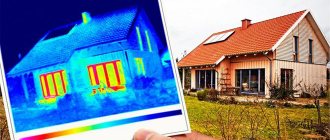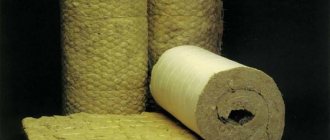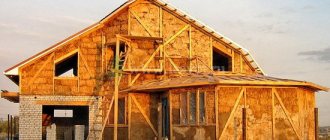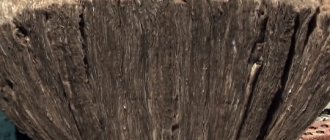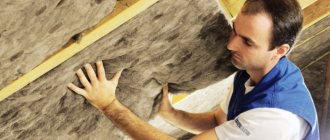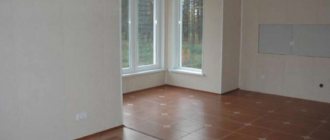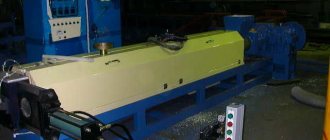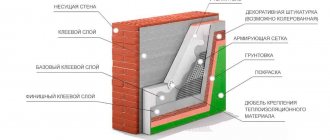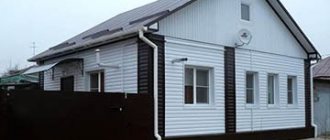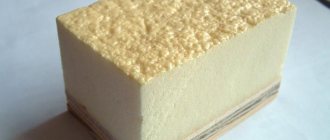What kind of insulation does mice not eat?
Any private home needs additional insulation.
And here the owner is faced with the question of what kind of insulation mice will not chew. After all, pests love places where it is warm and dry. There they make nests and dig passages to food sources. It can be very difficult to eradicate mice from insulation, and the material loses its properties due to the animals. There are two large groups of insulation materials: organic and inorganic. Mice gnaw more on materials belonging to the first group, but the second group also contains insulation that will be tough for pests.
Which insulation materials are not an obstacle for mice?
In order for your dacha to be reliably protected, you need to know its weak points. Unfortunately, most popular insulation materials are defenseless against rodents:
- Mineral wool;
- Expanded polystyrene;
- Polyethylene;
- Polypropylene;
- Reeds.
Mineral wool and materials based on it are almost an ideal nesting place for our unwanted neighbors. It does not rot, is well ventilated, but warm enough. At the same time, its soft structure becomes an additional bonus for rodents.
Other materials are produced on the basis of organic compounds. Some can even be digested by mice, not to mention making moves.
As you can see, many popular insulation materials fall into the category of unsafe materials. If you do not want to deal with problems associated with damage to the insulating layer, it is recommended to combine materials. For example, lay one of the hard materials around the perimeter that mice will not chew through, and lay mineral wool or any other insulation you need inside.
The insulation can also be impregnated with special compounds, such as borax, for example. True, this must be done at the preparatory stage, and not after installation, when the problem has made itself felt.
Organic insulation
For their production, waste from woodworking and agricultural production is used. Some types contain cement and plastic.
Such insulation materials include:
- Ecowool. Made from paper production waste.
- Fibrolite. Consists of wood chips.
- Sotoplast. It is made in the form of a honeycomb, filled with special fabric or paper.
- Foamed polyethylene. Made from polyethylene and a foaming agent.
- Expanded polystyrene. Better known as polystyrene foam.
- Polyurethane foam. Used to treat ceilings and walls.
- Chipboard and fibreboard. Contains wood waste.
- Arbolit. It is made from shavings, sawdust, reeds and straw.
The mice can easily gnaw through any of these materials and arrange them inside the shelter. In a wooden house, straw is often used for insulation, in which pests feel comfortable.
Insulation and rodents
Inorganic insulation
Mice cannot chew through these materials. They are solid, and it is impossible to stay inside due to the small amount of oxygen.
Insulation is made from slag, glass, asbestos and rocks. It can be hard and free-flowing and can be produced in the form of slabs, mats, and rolls.
This group includes:
- Mineral wool. It can be stone or slag. Stone wool is made from rocks. The second type is made from slag, which is obtained during metal casting. Mice will not breed in mineral wool, but they can chew through it.
- Glass wool. It is made from the same materials as glass or from glass production waste. This includes the following types of insulation: basalt wool (fiberglass) and slag wool. Her most famous.
- Perlite and vermiculite. Loose and hard. This insulation is not eaten by mice because it is very hard on their teeth.
- Foam concrete and aerated concrete. Used when working with ceilings, walls and floors.
- Penoizol. Expensive insulation that can be used in a built house.
Rodents do not breed in inorganic insulation materials. But in mineral wool it is easy for them to make moves. House mice in glass wool are also capable of gnawing a hole into a food source.
Waterproofing films are often laid on top of the insulation. They help protect the structure from excess moisture and extend the life of the insulating material.
To protect and insulate pipes, fiberglass is usually used, which rodents do not favor.
What mice won't chew
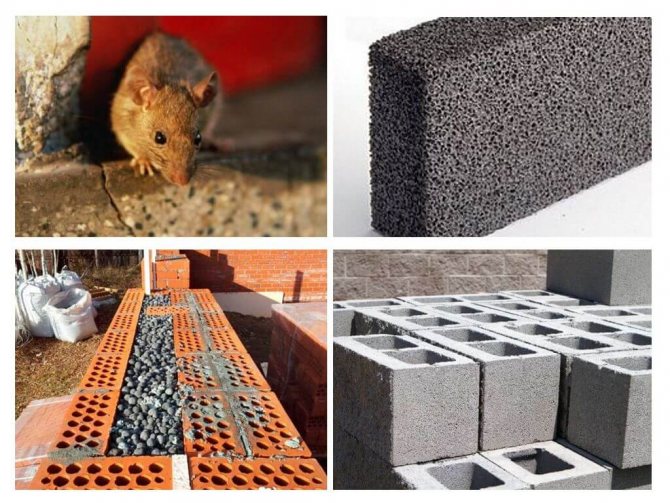
What Mice Don't Chew Solid insulation doesn't breed mice. They simply cannot make a hole for themselves in these materials.
Foam glass
It has sufficient strength, thanks to which it protects the house from the invasion of rodents and insects. There are two types:
The first type is used when it is necessary to insulate floors, ceilings and ceilings. Plates are used to insulate walls.
Foam glass has the following advantages:
- It does not emit harmful fumes into the environment and is safe for human health.
- Allows you to use a jigsaw or hacksaw, so it's easy to work with.
- The insulation is not affected by sunlight or moisture. It is durable and easy to operate.
- Rodents are not able to gnaw a hole in it.
- Prevents the appearance of fungus.
Although mice do not like this insulation, they can enter the room through the seams between the slabs. To prevent this from happening, you should use a sealant and lay the material on a solution whose quality has been confirmed by positive reviews.
It is made from special clay, which is cleaned and then formed into granules with a diameter of 10 to 25 mm. The granules are hardened at high temperatures, increasing their strength and reducing weight.
More often, expanded clay is used to insulate attic floors and basements, but the material can also be used for walls.
Mice will not be able to move in walls covered with expanded clay. They will simply drown in small fractions. The dust contained in the insulation will not allow rodents to breathe normally and will clog their noses, and the teeth of mice and rats will break on durable balls. Animals cannot survive in such conditions.
The material has the following advantages:
- It insulates walls well.
- Has zero fire hazard.
- Does not allow extraneous sounds to pass through.
- Inexpensive and durable.
- Provides reliable waterproofing.
Expanded clay is not used to insulate the walls of a wooden house. Brick walls are insulated during the construction stage.
Clay balls are also used to insulate the underground. To do this, small granules are selected and laid using the “dry screed” technology. In this case, expanded clay can be poured onto the ground or onto concrete.
It is produced in the form of blocks and in the form of a solution. The latter type is good because it does not have seams through which mice and rats can enter a person’s home.
Insulation is applied to brick walls on the street side or poured into the masonry during construction work.
Foam concrete is made from sand, water, foaming agent and cement. After hardening it becomes very hard. And if builders are concerned about the question of which insulation does not harbor mice, it is worth paying attention to this material. Rodents will avoid it.
Blocks are used to insulate walls. The floor is insulated with a solution. The material has many advantages:
- Houses made of foam blocks are warm, quiet and durable.
- The insulation does not absorb moisture and does not crack.
- Rodents, ants and cockroaches cannot live in it.
- Laying the blocks is easy because they are light in weight.
- The material is easy to process. It is sawed, cut and drilled if necessary.
Insulation is not used indoors, because condensation may form at its joints, which will cause the development of mold fungi.
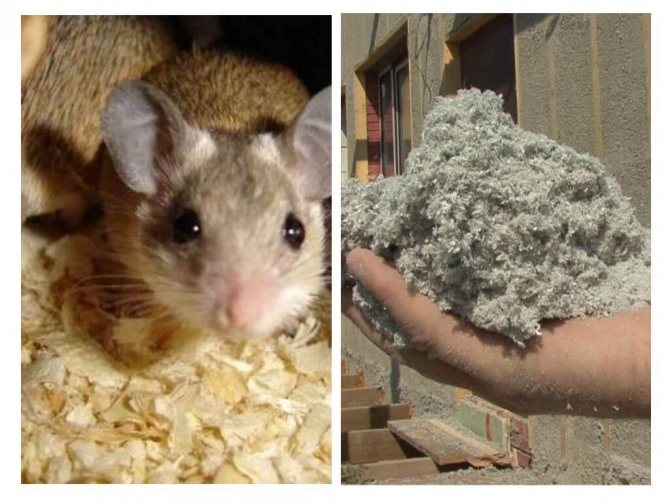
Ecowool and mice Insulation is a new material in construction, but it is becoming increasingly popular, despite its high cost. The fiber can only be applied with special equipment. After it hardens, it is leveled using a roller.
Thermal insulation material is produced from cellulose. It can be located inside and outside the building; it has no disadvantages in use.
The list of advantages of ecowool is as follows:
- It is safe for humans and animals living indoors.
- It muffles any noise that the street makes and keeps the house warm.
- Does not rot or decompose.
- It has a low fire hazard because it actively releases moisture when heated.
The material is light and soft, so some people don't understand why mice and rats can't chew on it. The fact is that ecowool contains orthoboric acid. It causes suffocation and dehydration in animals. If a pest wants to make a nest in the material, it will not be able to live there for long.
The acid is also endowed with antiseptic properties, and it is this that prevents the cotton wool from catching fire when heated.
What kind of insulation is not chewed by mice, rats and other pests?
Insulating a house with modern materials has the main goal of preserving heat in the house and reducing energy consumption costs. But often this goal is offset by the banal interference of rodents. Of course, for them polystyrene foam, mineral wool and other insulation materials are of no culinary value. But creating a comfortable nesting place in a warm mass of material is another matter.
Insulation in the house is a necessary thing
Against the backdrop of this problem, attempts are being made to get rid of annoying “roommates” with modern ultrasonic devices poisoned by baits. But these remedies are ineffective, and even a couple of cats in the house sometimes do not solve the problem.
The only solution seems to be the use of insulation materials, which are of no interest to the sharp teeth of rodents.
Despite the fact that the selected type of insulation must be resistant to attacks by rodents, it must also perform its main functions, having practical parameters:
- Thermal conductivity - the lower the coefficient of this characteristic, the more reliably the house is protected from cold temperatures
- Heat capacity - higher values of this parameter provide better heat retention
- Vapor barrier - if the insulation meets the standards of this criterion, walls and other structural elements are not at risk of infection by fungus and mold
- Sound insulation is an important argument, especially when insulating partitions and walls in multi-storey panel buildings
- Resistant to fire risk
In order not to experiment once again with the taste of rodents, you can immediately determine those insulation materials for the walls of a wooden house that are suitable for their interests:
- Basalt wool. Here rodents feel very comfortable, setting up breeding nests. Rats can live in such insulation until it turns to dust
- Foam plastic - when rodents cohabit, the supply of insulation may not be enough even for a couple of seasons
- Ordinary polystyrene foam is also an attractive home for rodents
But these animals feel discomfort when installing isolation:
- Penoizol. This is a type of foam, but with different components and structure
- Extruded polystyrene foam, the dense structure of which does not crumble and is not suitable for mice and rats to live in
- Aerated concrete with a hard structure that is too tough for rodents
- Ecowool, which contains borax, which is not of interest to rodents
But more effective insulation materials against rodents are expanded clay and foam glass.
Foam glass - insulation that mice do not chew
Foam glass is a persistent barrier for all types of rodents due to its dense structure and durable components.
This type of insulation is produced by foaming glass raw materials mixed with carbon. As a result, glass porous cells tightly adjacent to each other are formed.
Foam glass can be in the form of granules, blocks and even slabs.
This material, unlike polynor insulation, has an almost unlimited service life. In any case, foam glass will be an effective insulation throughout the entire period of operation of the house.
In addition to being unsuitable for rodents, foam glass has the following advantages:
- Immunity to temperature changes
- Inertness to erosion
- Ability to resist freezing of water
- Corrosion Prevention
- Resistance to deformation
- Resistance to negative manifestations of a biological nature
Foam glass has excellent vapor permeability. Its use is advisable when insulating large areas - public buildings, retail establishments, as well as private residential buildings.
But unattractiveness to rodents in this material cannot serve as the main deciding factor, since this material does not have the most favorable thermal conductivity indicators. With parameters of 0.047-0.052 W/m·0C, foam glass is inferior in this characteristic to mineral wool, polystyrene foam and polyurethane foam.
On a note. Thermal insulation of private buildings with a long service life with foam glass is not always rational, since the service life of the material is very long. If in a few years you have to repair insulated surfaces, you will have to dismantle the insulation layer and use a new one.
Technical characteristics of foam glass
Expanded clay - insulation that mice do not chew
Expanded clay has a porous structure and light weight. But this is quite enough to neutralize the interest of rodents in the insulation. This material appears in the form of small granules that are slightly reddish or brown in color.
The thermal conductivity of expanded clay is quite suitable for its use in insulating floors and attic structures. Although its coefficient is not the highest among similar materials - only 0.12-0.15 W/m*K.
When mixed with cement mortar, expanded clay can also be used for wall insulation. But in this case, due to the use of a cement base, the thermal capacity of the thermal insulator will suffer.
But the porous structure of the material also has a side effect - it is able to accumulate moisture. Therefore, when installing thermal insulation using expanded clay, it is necessary to prepare a waterproofing layer.
On a note. In order for expanded clay to truly provide the stated thermal insulation parameters, it must be laid in a dense mass. The layer of material must be at least 500 mm - only in this case the insulation will be rational.
Among the advantages of this material are its light weight and ability to withstand deformation. The durable structure of the granules also ensures resistance to chemical factors.
Technical characteristics of expanded clay
Reviews about which insulation mice do not eat
Reviews from home owners who insulated their homes with different types of thermal insulators differ for reasons of importance of priorities. But most positive reviews concern foam glass and expanded clay.
Foam glass is excellent for insulating wall and foundation surfaces. Expanded clay is more suitable for floor insulation, as well as for roof insulation.
In both cases, according to the results of reviews, with proper insulation, a high degree of effectiveness is noted. One of the priorities of many residents is the low cost of both materials.
Video about insulation materials that mice do not eat
The video briefly describes thermal insulation materials that are not to the taste of rodents. Their advantages and disadvantages are also mentioned.
Foam glass is a material that is often used to insulate the facade of a house.
Expanded clay is a product made from clay, which means it is environmentally friendly.
megabeaver.ru
How to protect insulation
To avoid having to think about how to get rid of mice in the insulation and spend money on new material, you should take care of the safety of your home during construction.
The following points should be followed, and rodents will not be able to damage the insulation or enter the home:
- To insulate the floor covering, use bulk material.
- Minimize the number of seams when insulating walls.
- Use roofing felt when insulating the roof.
- Finish the façade of the building with durable cladding.
- Make a strip foundation.
It is necessary to take care of the type of insulation before construction begins, because not all materials can be used when the building has already been put into operation.
If the house uses organic insulation, it should be rolled into concrete or covered with a fine mesh. In this case, rodents will not be able to create a mouse hole in it.
Sometimes mice still bother their owners, despite all the work done. Then you have to fight pests using available methods: turn on the ultrasonic repeller, set up mousetraps, lay out poisonous baits. You can have a cat in your home. Its smell will scare away rodents from human possessions.
Which insulation should not be chosen when mice are already infested?
If pests have already appeared in the house, then you should not use materials that have a light porous structure to insulate the home. It will be a waste of money and effort.
Such materials include:
- penoplex,
- foamed polyethylene,
- Styrofoam,
- expanded polystyrene,
- glass wool
To use these types, you first need to get rid of pests, and only then install them using protective materials.
What insulation is not chewed by mice and rats: an inedible “menu” for rodents
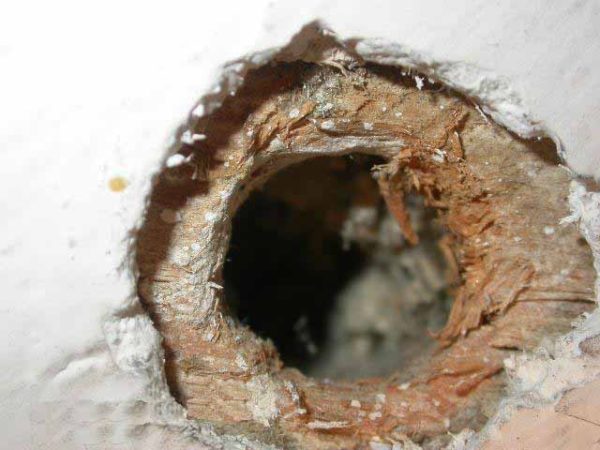
Insulating a house where mice live is not a trivial task!
I would like to consider one rather rarely raised question, namely, to figure out which insulation does not breed mice. For residents of apartment buildings, it is less relevant, but homeowners in the private sector quite often have to deal with a situation where the thermal insulation layer becomes unusable in just a few months.
So, how to insulate a house so that the material does not suffer?
Types of insulation that won't be chewed by mice
Having completed the construction or reconstruction of their home, many homeowners are faced with an unexpected problem: rodents make holes in the thermal insulation layer. Therefore, before starting construction or renovation, it is worth clearly understanding which insulation does not harbor mice. The consequence of the life activity of rodents is a violation of the internal structure of the material and loss of its integrity, it becomes unusable and requires replacement prematurely.
The reason why thermal insulation is attractive to mice and rats is very simple: it protects against the cold, making it comfortable to live in and raise offspring. In a short period of time, some of its species can turn into dust. As a rule, mice do not eat the insulation, but gnaw it in order to make a burrow in the resulting space. Sometimes the layer of thermal insulation turns out to be completely covered with passages that serve for the free movement of nimble animals. Mice are capable of chewing through almost any material, but there are still some that are too tough for them.
Review of popular insulation materials
In order to understand what type of thermal insulation will not be damaged by rodents, you need to familiarize yourself with its composition. Insulation materials are divided into two main groups:
- Organic (polyethylene, polystyrene foam, ecowool, peat blocks, natural cork, straw, reed and others).
- Inorganic (mineral and glass wool, vermiculite, perlite, expanded clay, foam glass, gas and foam concrete, penoizol).
The former are considered the safest for human health and environmentally friendly. But this means that these insulation materials are equally harmless to rats and mice. For example, rodents are big fans of polystyrene foam and expanded polystyrene. The exception is when these materials are used in the form of balls mixed with concrete.
This review would be incomplete without mentioning that among organic insulation materials, ecowool is considered an unsuitable home for mice. Although it consists almost entirely of cellulose, that is, recycled paper, rodents do not touch it. The fact is that orthoboric acid is used as an antiseptic in the manufacture of ecowool.
For humans, the dose used is absolutely safe, but when mice or rats gnaw the insulation, this provokes severe thirst in them and causes a feeling of discomfort. So they definitely won’t stay in such a place for long.
Thermal insulation from inorganic raw materials
Among this group, there are those that mice and their relatives like, and there are also those from which they will stay away. Thus, mineral wool is very attractive to rodents. Using this material they create cozy homes. The main advantages of mineral wool insulation are low density and high hydrophobicity, which are also attractive to mice and rats, as these qualities make their nest dry and warm.
But pests, as a rule, do not gnaw hard and loose inorganic materials. The disadvantage of these types of thermal insulation is that most of them can only be used at the stage of building a house.
Which material to choose?
The following are the main types of insulation that mice do not eat:
- foam glass - an environmentally friendly and durable thermal insulator, used for walls, ceilings, floors, basements and ceilings;
- expanded clay - produced by firing clay, retains heat well, is resistant to temperature changes and fire, provides a reliable barrier to extraneous sounds, including protection from impact noise;
- penoizol - insulation, which is often called liquid foam, but, unlike its “brother”, it does not become prey for mice, is not capable of spontaneous combustion and does not emit toxic substances;
- foam concrete is a durable and environmentally friendly material that consists of cement, sand, water and foam, suitable only for external insulation of a house;
- extruded polystyrene foam (EPS) - does not crumble and has a more closed structure than regular foam, so mice and rats, as a rule, do not touch it.
Recommendations for rodent control
Whatever insulation is used, there are methods that can protect the house from the presence of rats and their relatives:
- at the construction stage, select a strip foundation;
- scatter wood shavings soaked in slaked lime or copper sulfate, or broken glass around the perimeter of the floor;
- paint the thermal insulation layer;
- use durable wall cladding;
- place acoustic devices that repel mice and rats in the house;
- get a cat.
Thermal insulator and rodents
Never damage
At one time, figuring out which insulation is not chewed by mice, rats and voles, and which is “multiplied by zero” very quickly and with pleasure, I analyzed not only my own experience, but also specialized literature. As a result, all materials had to be divided into three groups, and here I will provide an overview of each of them.
Dense insulation, which is a porous substance in a hard shell, is almost never damaged by rodents. That is, the rat may gnaw through a hole in them (and what will it not gnaw through?), but it will be as short as possible, and therefore, if detected, we can easily seal it.
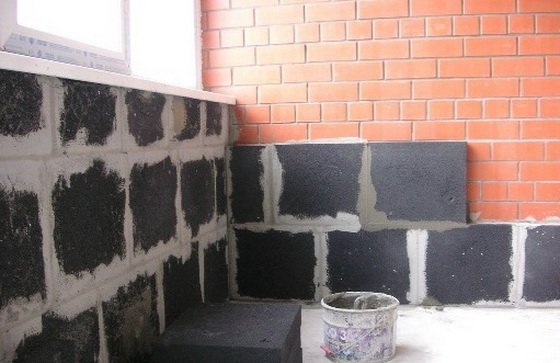
Thermal insulation made of foam glass will remain intact!
In this category I will include the following options:
- Foam glass is an ideal thermal insulation material from the point of view of protection against rodents, consisting of lightweight panels made of foamed silicate raw materials. The high strength of the foam glass cladding provides good protection from damage, and the small particles with sharp edges that form when chipped off injure the oral cavity of rodents, so they quickly give up trying to “test the foam glass.”
- Foam concrete is somewhat inferior to foam glass in terms of “mouse repellent” characteristics, but at the same time it has good thermal insulation ability. Dense foam concrete cladding is almost never damaged by mice or rats, especially if it is mounted on top of a wall made of durable materials (concrete, solid brick).
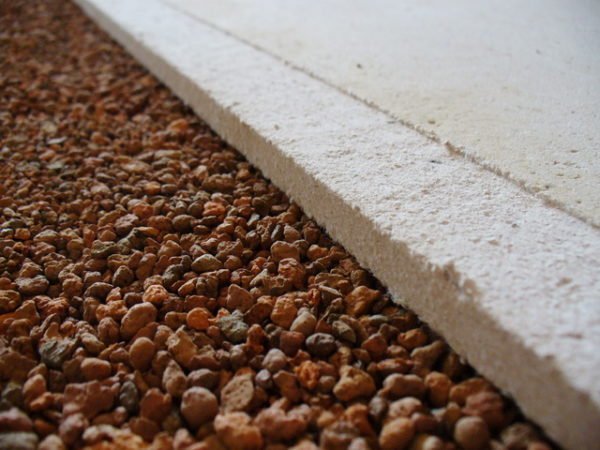
Mice do not chew expanded clay itself, but they can dig in it
- Expanded clay is granules of baked clay that are used for bulk thermal insulation. The advantages of this material are significant availability, reasonable price and ease of use. Neither rats nor mice chew expanded clay, but if necessary they can make passages through the expanded clay backfill. To prevent such a development of events, I either immediately pour expanded clay concrete into the cavities, or simply fix expanded clay granules with a liquid solution, which sets and turns the thermal insulation layer into a monolith.
- In the list of insulation materials that rodents ignore, I will include not only dense materials. There are also organic raw materials, which, in theory, should be very appetizing - ecowool. Despite the fact that the basis of the insulation is cellulose, orthoboric acid, which is part of the impregnation, effectively repels both mice and rats, causing them suffocation and systematic dehydration .
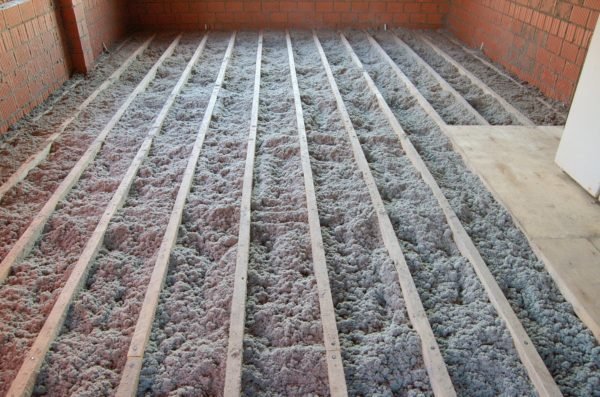
Paradox: mice don’t touch this loose substance
These four points need to be known to any owner for whom the priority is the protection of thermal insulation circuits from damage by rodents. If the problem with mice is episodic, i.e. They exist, but they don’t bother me too much yet – you can consider other materials.
Sometimes they do damage
In this category I included insulation materials, which, on the one hand, are of no “gastronomic” interest for mice and rats, but on the other hand, can be damaged and used to make nests. This list included:
- Mineral wool (both loose rolled materials and dense basalt insulation). Very often it is positioned as a material in which rodents do not live, but this is not entirely true: yes, the fibers themselves are rarely damaged by rats or mice, but at the same time the raw material can be easily chewed through and used to make nests. In addition, pests usually enter the room by literally seeping through at the junction of the panel of thermal insulation material to the sheathing or load-bearing surface: we lay the mineral wool so that it does not compact or deform, so rodents take advantage of it.
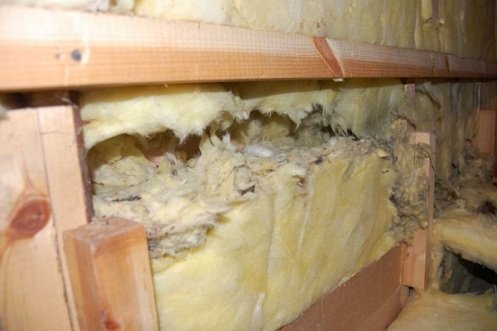
Mouse movement inside mineral wool: if there is an incentive, they will chew
- Extruded polystyrene foam. It is also a fairly dense raw material that rarely suffers from gnawing. Unfortunately, “rarely” does not mean “never”: a layer of polystyrene insulation will not become an insurmountable barrier for a rat, and if it decides to get inside, it will do so without serious difficulties, and even more so without consequences for its health.
- Self-expanding polyurethane foam. The material itself is quite dense and rats and mice gnaw it quite rarely. But over time, without proper protection, polyurethane gradually deteriorates under the influence of moisture and ultraviolet radiation... with a known result!
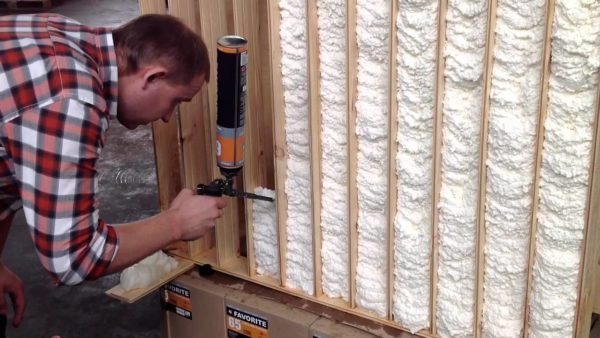
If you don't protect the foam, it will begin to collapse on its own, and rodents will speed up the process.
The instructions strongly recommend isolating polyurethane thermal insulation layers from the external environment, at least by painting.
- Finally, last on this list is glass wool. All its disadvantages, which anyone who has tried to work with fiberglass with their own hands knows, will become advantages here: a layer of 5 cm of this material is enough, and rodents will not go any further, fearing for their health without reason.
Be no stupider than mice - work with glass wool only with gloves, goggles and a respirator!
Chew easily and regularly
Above we looked at what kind of insulation mice do not eat, now it’s worth figuring out what materials can (and will definitely be) damaged:
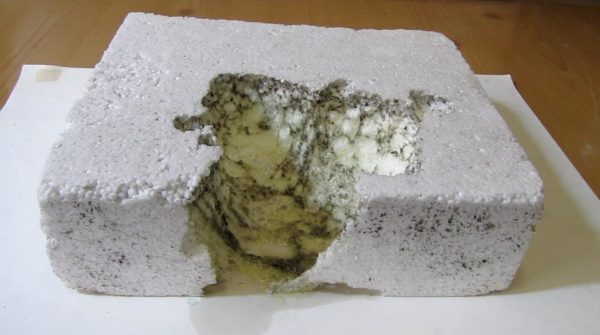
Photo of a foam block with a nest inside
- Polystyrene foam is the cheapest, most popular, and therefore probably the most sought-after insulation material. It gnaws through “in an instant”, spreads throughout the house, inside rats, mice and voles create entire labyrinths with nests, passages and warehouses. It is almost impossible to protect .
- Penoizol is a sprayed foam that, when hardened, forms a relatively uniform structure. It is a little worse to chew on, but with a large scale of rodent invasion, you “hardly” will not notice it.
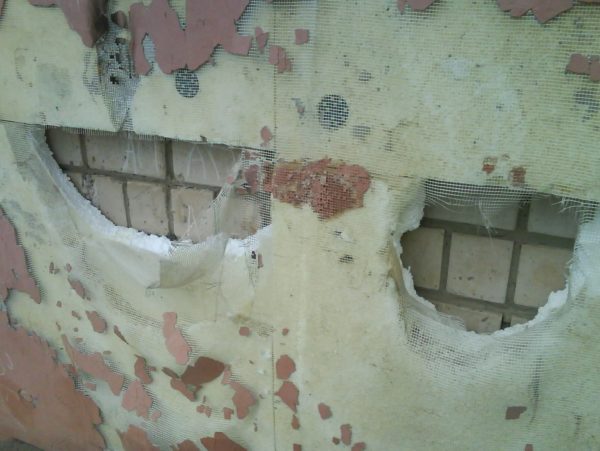
There was polystyrene foam - and there is no polystyrene foam
- Expanded polystyrene is somewhat denser than polystyrene foam, but this usually doesn’t bother mice much . If you used polystyrene foam for insulation, and you have a lot of mice, then you will soon see all the delights like gnawed holes, passages, nests with broods of young animals and white crumbs throughout the house.
Which insulation is best to choose to protect against rodents?
Are you planning to build a house and are wondering which insulation is best to choose?
In the article, we will consider in detail all the pros and cons of the most popular insulation for walls, floors and ceilings and answer the question of which insulation is not chewed by mice or rats, and we will find out how to protect a house from rodents during construction. A private home is always great! There are no neighbors drilling or flooding, you can listen to music until late or, conversely, spend quiet evenings reading a book. However, it is quite unpleasant when the integrity of the home is violated by mice, or even worse, by rats. They poison life with their existence, so they must be fought at the construction stage in order to prevent uninvited guests from entering the house.
So, now we know which insulation is not chewed by mice and rats, because it is too tough for them, or contains impurities that are unpleasant for rodents, and which material, on the contrary, will not protect against small pests if they are used to insulate a house. So which insulation is best to choose to protect against rodents? If you choose from a financial point of view, then expanded clay will be more budget-friendly, ecowool and foam glass will be more expensive.
Builders recommend insulating floors in a wooden house with expanded clay and sand. Any of the listed materials is suitable for walls and attic floors. If you choose based on what is more convenient to work with, then these are individual preferences and there is no clear opinion here. The main thing is to take insulation seriously, because 5% of an uninsulated area leads to 25% of heat loss, and therefore additional costs. Choose only among those insulation materials that will protect your home from rodents.
Rodents in the house are always a problem, and significant in several aspects at once.
- Rats and mice are simply unpleasant neighbors, and many people are also terribly afraid of them.
- They can be carriers of diseases dangerous to humans - for example, hemorrhagic fever with renal syndrome, leptospirosis, rabies. Moreover, the source of infection is not only the mice and rats themselves, but also their natural secretions, which they spread throughout the house and area.
- Rodents spoil property - from food supplies to the actual house in which they live.
Pests have a special “love” for thermal insulation materials - it is rare that mice do not live in any insulation, and it is rare that rats do not live in any insulation. They often gnaw through passages in the insulation, which directly leads to a decrease in the quality of insulation - through these holes, cold from the outside penetrates into the premises of the house. Why do rodents need this? Are they really interested in insulating materials from a gastronomic point of view?
It would probably be incorrect to ask the question “what kind of insulation does mice not eat?” The fact is that rodents sharpen thermal insulation with their teeth not at all because these materials are so tasty and nutritious for them. Their real motives may be:
- actually sharpen the teeth - rodents’ incisors grow throughout their lives, and animals are forced to constantly grind them down;
- overcome an obstacle to food - the insulation itself may not be of interest to mice, but only separates them, for example, from the place where cereals and vegetables are stored;
- make a nest in the thickness of the wall or directly in the insulation.
Thus, more correct options for formulating the problem would be “what kind of insulation mice do not gnaw” or “what kind of insulation mice do not live in.”
To understand which insulation is not chewed by mice and rats, you can go from the opposite - look at the types of thermal insulation that attract rodents and identify a number of patterns.
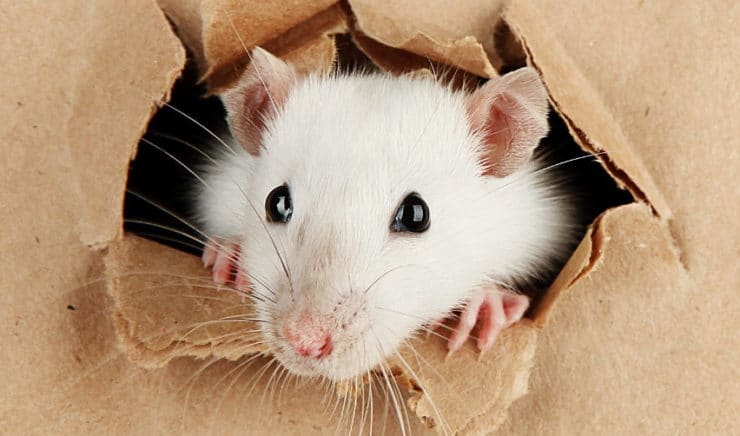
It can be noted that the most popular types of insulation among rats and mice are those that are characterized by low density. Moreover, if animals prefer to gnaw passages in polystyrene foam, then in the thickness of fibrous insulation, such as mineral wool or glass wool, they like to make nests - apparently, the loose structure reminds them of natural materials. And speaking of natural materials, rodents also enjoy using traditional types of eco-insulation materials, such as sawdust or hemp.
We suggest you read How to clean the hob? 7 effective tips and important recommendations
Thus, a truly bioresistant thermal insulation material should be:
- hard and dense
- if possible, have additional surface protection.
However, on the thermal insulation market today there are not many options that have the listed characteristics and at the same time are not deterred by price and have a minimum of technical restrictions on use.
For example, expanded clay is practically the first thing that comes to mind in response to the question of which insulation rodents cannot chew. Indeed, it is too hard for mouse or rat teeth. But at the same time, expanded clay implies the creation of a fairly thick thermal insulation layer, which will naturally have considerable weight - which means that it is contraindicated to use it where the lightness and/or thinness of the material plays a decisive role.
Another example of insulation that rats, not to mention mice, cannot chew on is foam glass. This material, which is available in various forms, from loose crumbs to blocks, has many advantages, including a wide range of applications, but it also has a serious drawback in the eyes of the average consumer - high cost.
A good balance between price and quality, including resistance to rodents, is demonstrated by polyurethane foam (PPU) thermal insulation - in particular, the latest generation of this type of material, based on polyisocyanurate foam (PIR). PIR boards (for example, products of the PIRRO brand produced by PirroGroup) have been entering the Russian market not so long ago, but extensive experience in their use in Europe and the USA proves that rats and mice, as well as insects and protozoa, are not interested in it.
The first reason for this is the high density and rigidity of these boards: the PIR compressive strength is 120 kPa or more (for comparison: for standard foam plastics with a density of 10-20 kg/m3 - about 50-70 kPa, for low-density types of wool - it is not standardized) . The second is the specific structure of polyisocyanurate foam, a closed-cell foam material.
It implies that the wall of each cell is simultaneously the wall of the neighboring one. The result is a single polymer frame, the integrity of which is much more difficult for a mouse or rat to break than, say, in the case of foam plastic or stone wool, which can be easily disassembled into individual balls or fibers.
In addition to resistance to biological influences, PIRRO PIR boards have a record low thermal conductivity - accordingly, they retain heat, perhaps better than all the materials presented today in the Russian construction mass market. Due to their low weight, they have no restrictions on their use in certain structures and are suitable for insulating any objects - from the roof to the basement.
In terms of durability, we can again refer to foreign experience - there are known buildings equipped with polyurethane thermal insulation several decades ago, and according to research results today, it still does not require replacement and has not changed its original physical and mechanical characteristics.
Returning to the topic of biosustainability of insulation, of course, one cannot deny the effectiveness of preventive measures in the fight against rats and mice. Rodents can simply be prevented from entering the house and, accordingly, the insulation. For example, a good option would be to get a cat with developed hunting instincts, and also periodically carry out deratization of the area.
When you choose a material for thermal insulation of your home (garage or other building), I advise you to focus not only on performance characteristics and cost, BUT also on the resistance of the material to pests (rats, mice and other rodents).
- Expanded clay. This is a low-toxic and environmentally friendly material. Inexpensive.
It is quite dense and round (too tough), it crumbles and it is difficult to make nests and passages in it, there is a lack of air due to small voids in the material
- Foam glass. Comes in different types (blocks, granules and crumbs). Expensive material. Has a shelf life of up to one hundred years. Also environmentally friendly.
It is too tough for pests due to its high strength. And fungi and microorganisms do not develop in it
- Ecowool. Insulation made from waste paper, which is treated with antiseptics. Fireproof, has good thermal insulation, high sound insulation, and environmentally friendly.
We suggest you familiarize yourself with How to clean aluminum at home
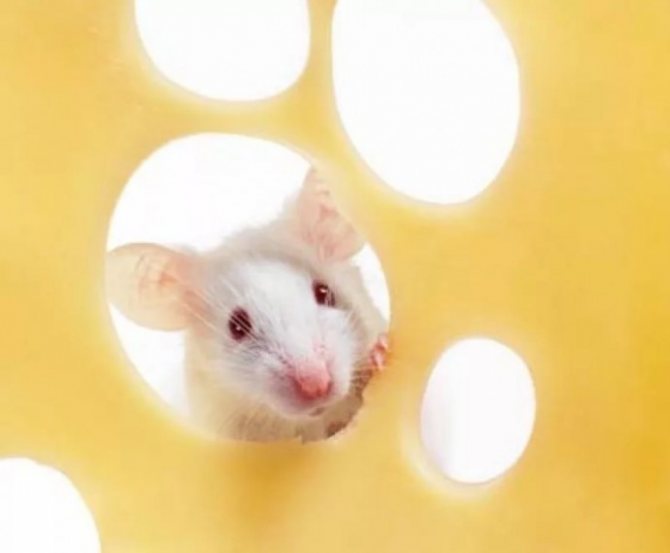
This material causes thirst in rodents and plus air deficiency due to the fact that ecowool is treated with orthoboric acid during production.
- Foam concrete. It has a long service life, is durable as a stone, accumulates heat well, and is lightweight. High degree of fire resistance and low cost.
This material is difficult for mice to chew on. Plus, this material is not of interest to rodents for housing construction.
- Penoizol. Durable material (at least 50 years), resistant to temperature fluctuations, non-flammable, easy to install, low cost.
The material contains formaldehyde, which rats do not like. And fine dust creates breathing problems for rodents.
I do not recommend using these materials for insulation to avoid pest problems.
- Mineral wool. It has a soft and non-aggressive environment, which is beneficial for the construction of nests and breeding.
- Styrofoam. This material is very popular with rodents, who not only build homes and make passages in it, BUT also eat it for some reason.
- Chipboards. Rodents do not eat chipboard, but easily chew through it and settle between the slabs.
- Extruded polystyrene foam. The composition resembles polystyrene foam. The thicker this insulation, the more mice like it, since it is warmer.
It is better to approach the choice of material more carefully. It’s better to prevent the appearance of rats and mice than to get rid of them later (long and painfully)
Insulating a house where mice live is not a trivial task!
I would like to consider one rather rarely raised question, namely, to figure out which insulation does not breed mice. For residents of apartment buildings, it is less relevant, but homeowners in the private sector quite often have to deal with a situation where the thermal insulation layer becomes unusable in just a few months.
How to protect the thermal insulation circuit from damage
If you got a house with a ready-made thermal insulation layer, or the mouse population suddenly began to increase, you need to take measures to protect the insulation. Otherwise, within a couple of years, heat loss will increase, and with it, heating bills will increase.
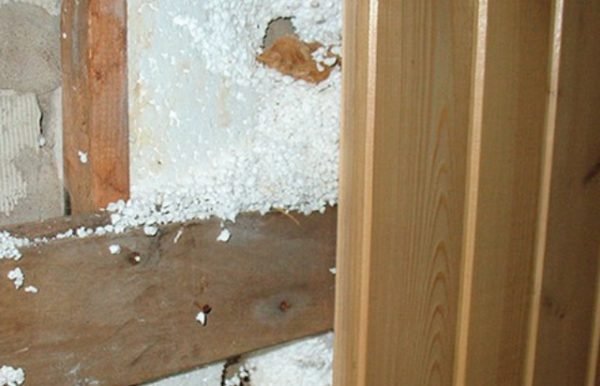
Any gaps in the casing will be used against you!
There are several options here that I would recommend implementing comprehensively:
- We protect all thermal insulation layers with dense material, preferably one that is too tough for a rodent.
- We fill the cavities and discovered passages with broken glass, wood shavings soaked in copper sulfate, or push glass wool.
- We store all food products and seed in a place inaccessible to mice. No food means no incentive to gnaw and seriously settle down in the insulated walls.
- We place poison behind the casing and in the corners, and install ultrasonic devices that repel rodents.
Well, and the most effective method, which, in addition to getting rid of rodents, has a bunch of other useful effects. Finally, get a normal cat, and every morning you will find several gray carcasses on the porch. Sooner or later the mice will run out and your insulation will be safe.
The owner, he was the one chewing the foam!
The cat, however, will stay and ask for food, but it seems to me that this is a completely acceptable price for peace and order in the house.
Names that are not recommended to be used
Experts advise to be especially careful with materials such as mineral wool, chipboard, polystyrene foam, extruded polystyrene foam: mice actively breed in them, build nests, and breed offspring. Rodents love to live in such an environment - warm, dry, isolated from dangers.
In particular, the insufficient strength of foam plastic leads to the fact that rodents make passages in it, form holes, and eat. Over the years, the material is completely “recycled” by pests, leaving structures unprotected. Mineral wool is a non-aggressive, pliable, fairly soft medium that allows rodent colonies to thrive.
Particle boards are not eaten by rats, but they inhabit the cavities between the panels and create tunnels. Extruded polystyrene foam is similar to polystyrene foam, although pests do not feed on it. The thicker its slabs, the more suitable they are for living and breeding mice - they are warmer.
These names of insulators are difficult to fully protect: mechanical, chemical and folk methods work only superficially and subject to their competent, timely and complete use.
Examples of insulation materials that are not interesting to rodents
When studying information about which insulation is not chewed by mice and rats, first of all you should consider expanded clay, ecowool, penoizol, foam glass, foam concrete.
It is made from clay using high-temperature firing. A lightweight, smooth material characterized by a porous structure is formed; this budget option exhibits impressive thermal insulation properties. Its variations are actively used:
- gravel in the form of brownish pellets, round or oval in shape;
- crushed stone - crushed pellets of different sizes, distinguished by sharp edges, they are often used in concrete mixtures;
- screenings - waste generated during the crushing or firing of expanded clay; this is a popular porous filler.
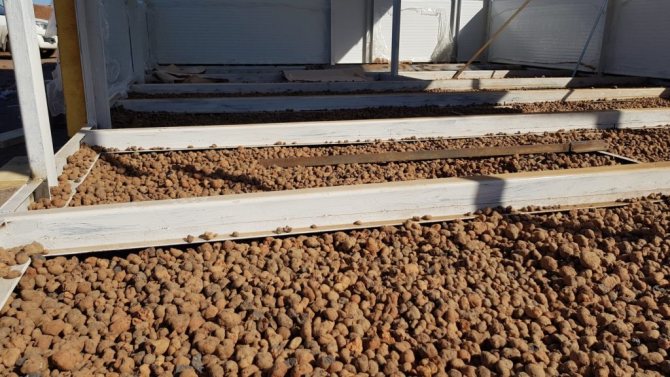
Expanded clay, which is quite safe in terms of composition, is not interesting to rodents, since its mechanical density and roundness harm the teeth, the insulation crumbles, so it is difficult to create passages and nests in it. The voids characteristic of screenings and rubble are insignificant, there is too little air for rats and mice.
The raw material for these cellulose products is paper waste, which is impregnated with fire retardants and antiseptics. When deciding which insulation mice do not eat, it is worth turning to this option: the orthoboric acid present in the composition provokes oxygen deficiency and thirst in rodents; they do not stay long in such an environment.
Ecowool has a number of advantages:
- low thermal conductivity;
- possibility of installation using a seamless method;
- excellent sound and heat insulation;
- environmental friendliness;
- fire safety;
- ability to balance humidity levels;
- resistance to fungi.
The only disadvantage is the complexity of installation: the material must be laid in such a way as to prevent its deposition.
Wood fiber retains its thermal insulation properties by allowing moisture to pass through it. Even if the humidity level exceeds 20%, ecowool does not lose its ability to insulate, unlike mineral wool, which cannot tolerate even 5%.
One of the brightest representatives of materials that do not harbor rodents. The service life of the product exceeds 50 years; penoizol is also characterized by several positive aspects:
- immunity to temperature fluctuations;
- fire safety;
- resistance to fungi and mold;
- ease of installation.
Uncured raw materials exhibit high fluidity, so they are used to fill all kinds of structural cavities. The budget option can be quickly installed and is suitable for older houses. Penoizol contains formaldehyde, which performs antimicrobial functions and is dangerous for rodents. Fine dust prevents them from breathing fully.
Foam glass
The production of this material started in the first third of the last century: initially, engineers developed options suitable for floating structures, then it was discovered that they could boast high sound and heat insulation characteristics.
For production, waste glass is used, which is ground, combined with gas-forming reagents and the mixture is processed in a high-temperature furnace. The mass is sintered, and during heat treatment, gases are released, which are the basis for the cellular structure of the material. At the final stage, foam glass is molded into standard blocks. You can find granulated foam glass on sale; it can be confused with expanded clay, although the former is gray in color.
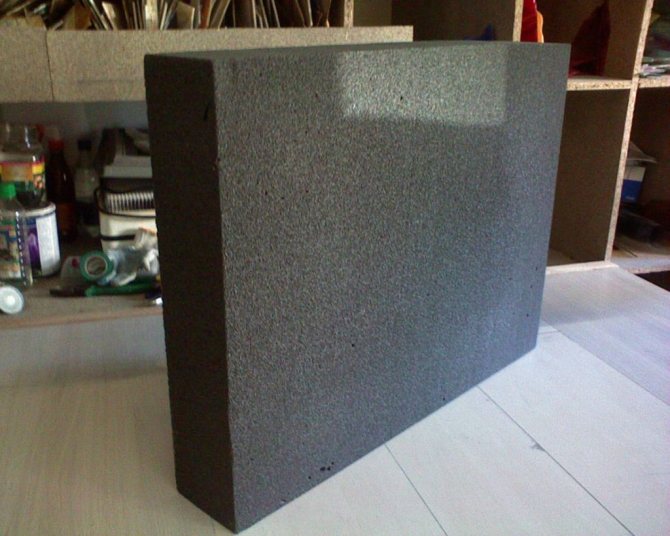
Foam glass - insulation that mice are not interested in
Expensive products have significant operational advantages, the main one being their unattractiveness to rodents. The working life reaches one hundred years, the raw materials do not shrink, they are safe from the point of view of sanitation and impact on nature, they cannot be compressed or bent. The high strength of foam glass prevents mice and rats from gnawing it. This environment is not suitable for the development of microorganisms and fungi.
The product is obtained mechanically: the mixture is constantly stirred so that air bubbles disperse uniformly throughout the entire mass. The reliable material is characterized by a long service life, it is not afraid of rotting, and is comparable in strength to stone. High thermal performance is manifested in the fact that foam concrete accumulates thermal energy, thereby optimizing heating costs, with its help it is easy to balance the level of humidity in the room and achieve a healthy microclimate.
The solution has a relatively small own weight and density; it does not create difficulties in processing and installation. The material perfectly absorbs sounds, is environmentally friendly, the blocks can be fixed with glue, which makes subsequent finishing work easier. Inexpensive insulation has the highest degree of fire resistance.
Enhanced mechanical strength and specific structure determine the resistance of this option to rodents. But during operation, microcracks form in it, which can harbor small insects.
What type of insulation does not allow mice to grow in?
Insulating floors, walls and ceilings allows you to significantly save on heating costs, as well as rid your house or apartment of dampness, cold and drafts. The modern market is characterized by a wide range of products varying in price, quality and component composition. No less important is the question of what kind of insulation mice do not eat.

Why is thermal insulation so attractive to animals and pests? It is very comfortable to live and reproduce in it. Most often, mice do not eat the insulation, but gnaw it, as a result of which the internal structure, integrity and functionality of the material are disrupted. Which option should you choose and what should you do to protect yourself from rodents during the construction and operation of the building?
The most popular methods of thermal insulation: general information
Before you start talking about what kind of insulation to use to prevent mice from getting in, you need to list the most popular materials:
Organic:
- expanded polystyrene;
- polyethylene;
- ecowool;
- reeds;
- Solomit, etc.
Inorganic:
- soft (mineral and basalt wool, mats based on flax fiber);
- bulk (vermiculite, perlite, expanded clay);
- inflatable (penoizol).
1. Mice and organic thermal insulators.
Such insulation is completely safe for human health, but what is good for the residents themselves is not at all bad for pests. Thus, foam and polystyrene foam are very fond of being chewed by mice and rats. The only exception is when this material is crushed into individual balls and mixed with concrete.
2. “Edible” and “inedible” soft inorganic insulation materials.
Rodents like mineral wool; it is soft, which means the mouse hole will become cozy. A mound of broken glass in those places where pests are most likely to enter will help save the situation.
Unlike mineral wool, basalt stone wool does not attract rodents, as it is produced on the basis of rock. In addition, this material has excellent soundproofing characteristics and can withstand heating up to 1000 °C without burning.
Flax fiber contains lignin, which is not absorbed in the body of rodents, so mice not only do not eat such insulation, but also do not settle in it.
Separately, I would like to mention ecowool. It is 80% cellulose, which is essentially recycled paper. Why isn't it an ideal home for rodents? However, they do not spoil this insulation, because it contains orthoboric acid. It causes severe thirst and a feeling of general discomfort; rodents will definitely not stay in such a place for long.
Loose and granulated expanded clay is produced by firing clay. Rodents do not settle in sand, granules or expanded clay concrete, but reliable protection from moisture, cold and drafts is guaranteed. Most often, walls and floors are finished in this way, as well as cavities in various building structures are filled.
Penoizol is also called liquid foam, but mice, like other pests (insects, microorganisms, fungi), avoid it. This type of thermal insulation is easy to install and durable in operation (about 70 years). It does not burn and does not emit harmful substances into the air.
How to protect thermal insulation from mice?
- Build a strip foundation.
- Place broken glass or wood shavings soaked in copper sulfate or slaked lime around the perimeter of the floor.
- Paint the insulation itself.
- Use durable cladding material when finishing walls.
- Place acoustic devices in the building.
- Get a cat.
Author: Roman Medvedev
| Related articles: | |
| How to glue foam boards to concrete Insulation for facades under plaster Mineral wool brand Knauf | |
Criteria for choosing the optimal insulator
When figuring out which insulation mice do not live in, you cannot rely only on the factor of resistance to rodents: it is important that the material performs the function expected of it - protects against heat leaks and helps maintain a comfortable microclimate. When choosing, you need to pay attention to the following indicators:
- coefficient of thermal conductivity;
- fire safety and fire resistance;
- durability;
- breathability;
- the degree of sound insulation created;
- environmental safety;
- waterproof;
- biostability.
According to the experience of homeowners, there are very few materials that mice and rats cannot tolerate. Expanded clay is considered the best in this regard, but it is problematic to insulate vertical structures with it. Polystyrene foam, on the contrary, is completely destroyed over the years.
Ways to protect insulation from rodent infestation
The possibility of pests becoming interested in insulation should be taken into account even at the stage of building construction, because it is extremely difficult to fight them in a habitable house. Experts offer the following solutions as effective prevention:
- metal mesh,
- ultrasonic repellers,
- boric acid.
Fine-mesh metal mesh is recognized as the most effective option for preventing the infestation of mice and rats. For this purpose, steel variations with a galvanized coating are optimal. The mesh is actively used as a component of floor thermal insulation; it also covers the base: the protection height must be at least one meter.
If a completed, commissioned house has been attacked by rodents, it is worth using ultrasonic repellers. Even if they are not always cheap, they do their job perfectly, preventing the spread of pests - they leave such a house.
Experts also advise coating particle boards with boric acid - rats and mice do not like it. This technique has long been adopted by manufacturers of building materials.
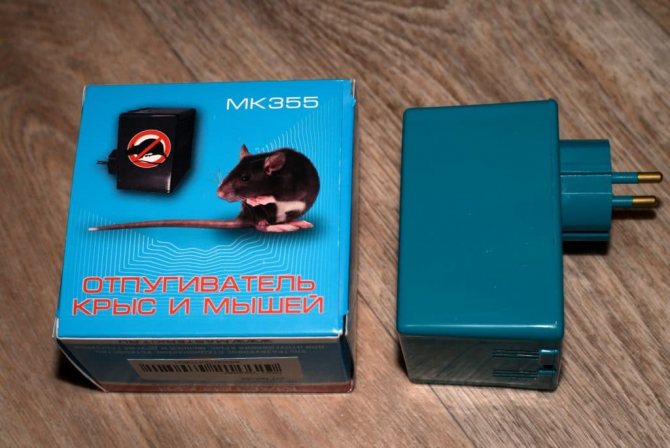
Ultrasonic repeller - a way to protect insulation from rodent invasion
The method that has been tried and tested for centuries works most often - bringing a cat into the house. Mice are afraid of them at the genetic level; they cannot stay in this dwelling. Having a pet helps keep both your nerves and your insulation intact.
As folk remedies, craftsmen recommend covering insulating materials during construction with tobacco dust, ash, mixed with slag, dry twigs of pine, wormwood, mint - all these products are very unloved by rodents. Hot peppers can also be an excellent option - the pods are placed tightly along the walls. Many experienced builders coat the materials with a solution of lime or borax before laying.
What insulation materials do mice and rats prefer?
The favorite materials of rodents are those that are suitable for creating nests and are easy to crumble, which is not a barrier to entry into the house. They allow them to sharpen their incisors, as they grow throughout life and need to be ground down regularly.
Pests do not consider any thermal insulation material as food. They chew not because they want to satisfy their hunger, but only to remove obstacles on the way to food and vegetables in the room.
Unsustainable materials
The love of pests for insulation is completely justified. This type of material is suitable for arranging nests and passages in it.

The main types of unstable thermal insulation layer:
- Styrofoam. Affordable and popular insulation in the form of individual slabs, with a low level of thermal conductivity. It does not pose a serious obstacle to the teeth of mice and rats. They instantly damage its integrity and create not only nests inside, but also entire labyrinths of passages.
- Glass wool. Not as attractive an option as the previous one, but still does not rot, retains heat and shape, and is characterized by good ventilation. The irritant effect of glass wool is not able to repel these animals.
- Penoplex. It is characterized by a denser structure than polystyrene foam, since it has increased resistance to moisture. Used for insulating attics and basements. But its properties do not prevent the invasion of mice and rats. Over time, nests, passages, manholes and labyrinths of animals will appear in it.
- Foamed polyethylene. Its base is foamed cellophane, covered on both sides with aluminum foil. Valued for its immunity to moisture. Used for insulating interior walls. Not able to resist pests.
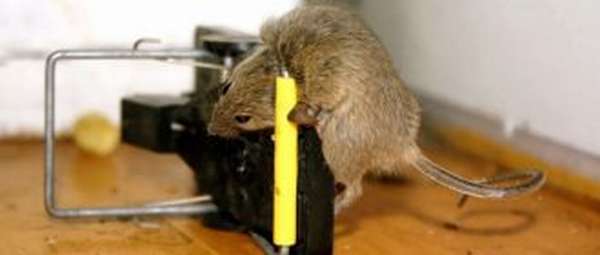
Be sure to read:
How to deal with mice in an apartment, what to do: effective methods and means
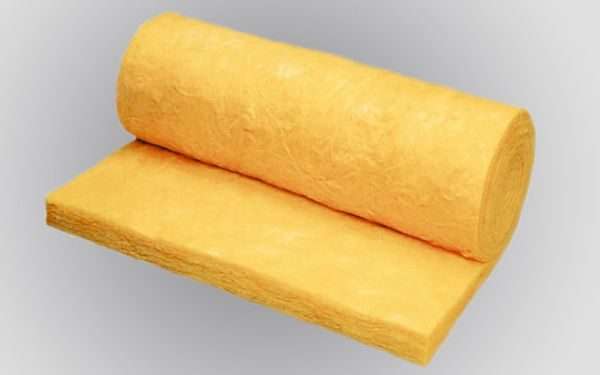
Sustainable insulation
A characteristic feature of mice is the ability to penetrate very narrow defects in foundations and walls that form during construction. Once inside the house, they begin to multiply en masse. As a result, it will be extremely difficult to smoke them out of there. Therefore, for thermal insulation of floors and walls, you need to choose a type of material that will not become a habitat for small pests.
This type of protective coating has long become very popular as insulation, as it has several advantages. In addition to thermal insulation properties, it absorbs noise. And besides, rodents cannot live in it.
Expanded clay is made from clay, which is cleaned of impurities during the production process, then thoroughly ground and mixed until a homogeneous consistency is obtained. Small granules are formed from the solution, which are subsequently hardened under the influence of temperature and pressure. In this case, the maximum permissible technical and operational characteristics are achieved. The mass swells, significantly increasing in volume. The strength of expanded clay is great, so it can withstand strong impacts.
Important! The material is available in the form of small, medium or large fractions. The latter has granule sizes up to 25 mm.
Rodents and insects cannot live in such insulation, since they will simply drown in small particles. In addition, there is a lack of oxygen in the insulation cake made from this material. Mice will also not be able to gnaw through it, since it is too durable. Therefore, the colonization of houses thermally insulated in this way by rodents is unlikely.
Foam glass
This type of thermal insulation coating is protected from biological factors. The coating is made in the form of slabs, as well as scattered. The latter has similar properties to expanded clay and is used in the same way for insulating basements and floors.
The slabs are mounted on walls from the outside or inside; in addition, they can be laid on floors by attaching them to a concrete base, bitumen, mastic or other types of construction binders.
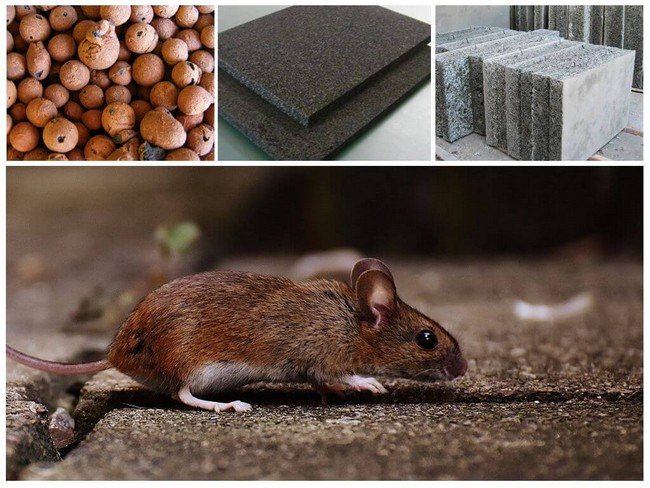
Foam glass is a special material that is made by melting and foaming glass. Due to the ability of the raw material to soften at high temperatures, a reliable, lightweight insulation is obtained. When the mass begins to solidify during the production process, it acquires high strength. Due to such operational and technical characteristics, rodents will not be able to penetrate the cake layer.
Important! Be sure to monitor the reliability of the seams and mortar.
To prevent rodents from moving into your home, many experts advise using this material. Ecological wool was invented relatively recently, but has already become one of the most popular types of thermal insulation coatings.
It is mounted using special devices. Then you need to level the layers with a roller.
Why don’t mice and rats eat such insulation? Rodents prefer to avoid settling in it due to its chemical composition. During manufacturing, orthoboric acid is used, which is dangerous for animals. When ingested, suffocation and dehydration occur. Even if an individual settles inside such insulation, they will not be able to stay inside for a long time.
In addition, thanks to the use of organic substances in ecowool, insects do not appear and fungus does not multiply. It resists open flame well.
This type of material is not suitable for mice, rats, or ants. It is produced in several forms: blocks and mortar. The first ones are used for the construction of buildings or secondary lining. The second is for filling the formwork.
Foam concrete consists of cement, liquid, sand and foaming agent. When hardened, it reaches high levels of rigidity and porosity. Foam concrete becomes an insulation material that does not harbor mice and ants due to its high strength.
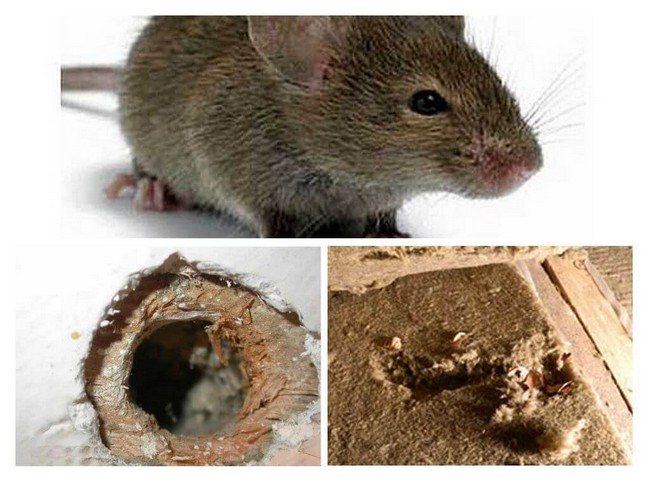
It is mainly used for external thermal insulation of buildings. The solution can also be poured between two layers of brickwork. Among all the advantages, there is a disadvantage: there is low resistance to moisture and mold formation.
Available in liquid form. It is sprayed onto the walls. And although rodents are unable to live in it for a long time, mice, however, eat it. Therefore, they can quickly ruin it.
Do mice grow in ecowool? What kind of insulation is not chewed by mice and rats? Do they breed in ecowool?
In a private house it is impossible to do without heat-insulating materials in the walls, floor or ceiling. During cold seasons, it is necessary to insulate your home with upholstery. Incorrectly chosen material may be susceptible to attack by rodents, which hide from frost and wind by constructing burrows. In order to avoid proximity to mice and rats and not regularly resort to repairs, it is necessary to understand what kind of insulation mice and rats will not chew on.
Rodent resistant materials
Mice in upholstery
All insulation materials can be divided into 2 categories.
- natural;
- artificial.
The first type consists of natural components that are pleasant to pests. They will happily settle in natural material, eating it and making holes.
Dryness and warmth are two of the most important factors that mice require to live. Insulation materials meet basic requirements, allowing rodents to live inside.
On a note! It is recommended to select in advance an insulation material that is not eaten by rodents. It must be durable so that rodents cannot chew it for their burrows. Among the insulation materials in which rodents do not live are expanded clay, penoizol, ecowool, glass foam and concrete.
Foam glass
Initially, the material was created for floating structures, and a little later they learned about its heat-insulating properties. Since then, foam glass, created from glass waste, has been actively used in this area. The material is produced in the form of slabs that are easy to saw and hold glue.
Advantages:
- resistance to parasites;
- strength;
- durability reaching up to 100 years.
Expanded clay
Expanded clay
The material is created by firing clay. After this, a light and smooth expanded clay with a porous structure is obtained. The composition is made up of completely natural ingredients, but does not contain substances that allow the formation and development of mold and mildew. A compactor in the form of screenings, crushed stone or gravel completely fills the space, not giving rodents the air they need for life. The material is unpleasant for the teeth of mice and rats, so they avoid it.
Advantages:
- not afraid of pests;
- environmental cleanliness;
- affordable price.
Penoizol
Insulation materials tend to last up to 50 years. The material completely occupies all free space, leaving no gaps or cracks. Penoizol contains antifungal substances that are harmful to mice and rats. Rodents prefer not to live in such material.
Advantages:
- fire resistance;
- safe, environmentally friendly composition;
- easy installation.
Foam concrete
The main feature of the material is its fire-resistant qualities. Durable foam concrete is considered a reliable thermal insulator that can normalize heat and moisture in a room.
Advantages:
- fire safety caused by resistance to fire;
- soundproofing;
- reliability and durability.
Ecowool
Ecowool
The material is made from paper impregnated with antiseptics and anti-feathers. Unlike similar glass wool, in which mice live, environmentally friendly wool does not lose its heat-insulating qualities when exposed to water. Pests do not settle inside the insulation, since the upholstery limits the supply of oxygen, which causes a lack of air in rodents who want to immediately get out.
To the popular question, do mice eat glass wool, the answer is yes.
Advantages:
- good noise insulation;
- safety;
- seamless styling;
- fire resistance.
Materials susceptible to rodent attack
Many people, noticing mice on their territory, try to get rid of unwanted guests. Any methods: traps, chemicals, repellers will be useless if the upholstery is made of material in which pests can comfortably live. These include mineral wool and polystyrene foam.
Styrofoam
The tool is widely distributed among users. It is preferred as an insulation material only because it is considered affordable. On the one hand, polystyrene foam is harmless to humans, resistant to fire and durable. On the other hand, rats love to build their holes in this kind of insulation. Polystyrene foam is not durable, so it is easily deformed under the influence of pest teeth. In addition, rats and mice love to eat this material.
Extruded polystyrene foam and chipboards
The insulation is considered favorable in terms of price, but it is not dense, therefore it is convenient for rodents to penetrate inside. When mice get into the layers of EPS, they disrupt its structure, negating all its beneficial properties.
It is important to know: the same fate awaits chipboards. Rats and mice do not feed on the material, but easily move through it
What insulation materials can cause damage?
In addition to materials that are protected from penetration and consumption, there are also less safe ones. Mice settle in them and make passages in them, which can lead to drafts. These include:
- basalt wool;
- EPPS;
- self-expanding polyurethane foam;
- glass wool
Mineral wool
The coating is considered completely environmentally friendly and safe. The material is excellent for the colonization and reproduction of mice. Therefore, if there are complaints about the dominance of rodents in your place of residence, it is undesirable to use it. The best choice for using basalt wool would be the thermal insulation of urban high-rise buildings, where rodents are extremely rare.
Important! Basalt wool is not used by small animals for food, but they can populate it or make passages in its thickness.
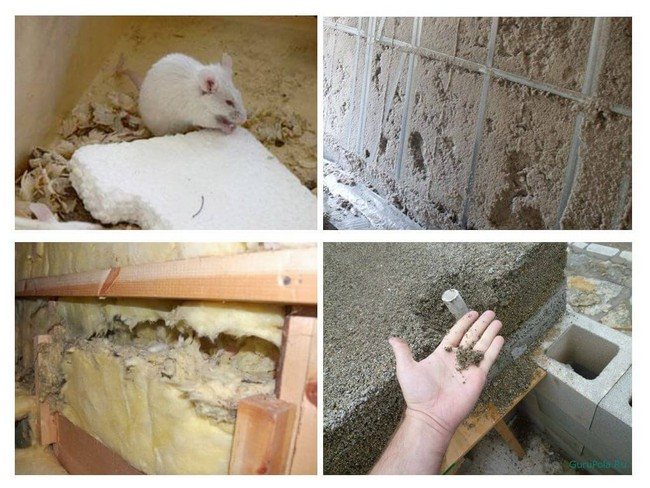
Extruded polystyrene foam
Eps is a synthetic material that has been used since 1941. It is often used for thermal insulation of plinths and plaster facades. Can be used for roof installation.
Unfortunately, mice love it as much as architects. Despite zero nutritional value, they are able to colonize in it, which leads to the appearance of an abundance of passages.
Self-expanding polyurethane foam
The material is much more often used for waterproofing floors. Despite the quality of the coating and its ability to resist the penetration of moisture into the house, rodents live in such coating for a long time. Therefore, it is worth using self-expanding polyurethane foam very carefully in regions with a dominance of mice and rats.
Glass wool
It is a well-known fact that mice live in glass wool. In addition, they are able to consume the insulation as food. Today it is rarely used, but when choosing it as insulation, you need to be careful during installation. If there is a prevalence of rodents in the region or there are many fields or warehouses nearby, animals may enter the house.
What kind of insulation is too tough for mice - the most common types
Every manufacturer strives for profit. For this purpose, advertising tricks and gimmicks are used. Thus, many manufacturers of home insulation are silent about their disadvantages and only show off their advantages. We are not involved in advertising, so we will impartially describe the three most common types of insulation that mice do not like - foam glass, ecowool, and expanded clay. Now about each in a little more detail, why are these insulation materials too tough for mice and rats?
- Foam glass This material resembles pumice. For production, a mixture of glass chips and reagents is used. The insulation turns out to be quite durable, so it will not be chewed by mice and rats - therefore, it is not interesting for their life. Foam glass has quite a lot of advantages: durability, environmental friendliness, does not absorb moisture, high strength, does not shrink, fire resistant, easy to install. Perhaps the disadvantage will be the relatively high cost. This insulation has many derivatives - it is combined with sawdust and other impurities, which leads to both a decrease in cost and quality. Foam glass is made in the form of layers of various shapes and granules.
- Ecowool Ecowool is considered safe for humans, as it is made from cellulose. But why then don’t mice and rats chew on this insulation? The fact is that it is impregnated with antiseptics. Ecowool contains orthoboric acid, which causes thirst and lack of oxygen in mice. Boron is also added to ecowool, which leads to fire protection. The insulation is easy to use, resistant to fungi, has excellent sound insulation, but has some disadvantages: it has low compressive strength and can cause allergies upon contact due to the antiseptics it contains. Recently, this is one of the most popular types of insulation, in terms of price-quality ratio, and most importantly, ecowool protects the house from rodents. No mouse can get through.
- Expanded clay We got to the most common insulation material that is resistant to rodents - expanded clay. Expanded clay is quite often used in construction, it is easy to use, and does not cost as much as other types of insulation. Expanded clay chips can be small, medium, large. Expanded clay is made from clay by firing, therefore it is completely safe for humans. When a mouse gets into expanded clay, it understands that it is impossible to chew it, and it is quite difficult to pass through such bulk material. According to statistics, expanded clay is the most common insulation material used to protect a home from rats and mice.
We suggest you familiarize yourself with How to remove mold (fungus) from walls at home with your own hands
So, we’ve looked at those types of insulation that rodents don’t like, but what kind of insulation suits them perfectly?
What they chew easily and regularly
Some materials are constantly attacked by rodents. These are mainly foam materials consisting of organic substances. This must be taken into account if there are agricultural buildings nearby. In this case, the risk of unexpected guests entering is very high.
Important! Foam materials are most susceptible to rodent attacks.
Polystyrene foam and polystyrene foam
The most nutritious materials for mice are natural insulation materials such as polystyrene foam and polystyrene foam. The soft, porous material will definitely become a home for mice and rats if it is not additionally protected. For safety, special metal grilles and chemical protection should be used.
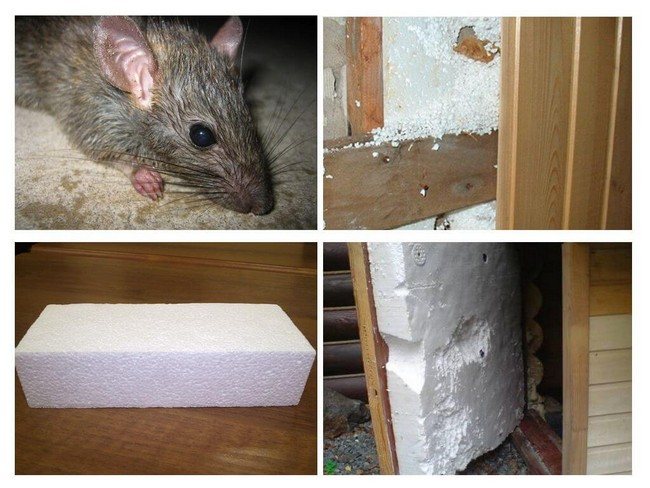
The material is soft. After applying layers and leveling, you get a fairly flexible insulation cake. Therefore, mice can settle in it and breed for a long time. No country house owner will like this. It is necessary to additionally use special grilles to prevent rodents from entering from the outside.
Expanded polystyrene
PPS, like polystyrene foam, will become a home for mice if it is not additionally protected. In addition, such a coating, if its integrity is compromised, loses all performance qualities. Therefore, it is undesirable to use polystyrene foam in places where rodents live.
There are many types of thermal insulation materials. When decorating houses and apartments, it is better to use those in which rodents will not want to live. These include expanded clay, foam glass, glass wool and others. In foam insulation (penoizol, polystyrene foam and others), mice live with pleasure, working out grandiose moves in them.

